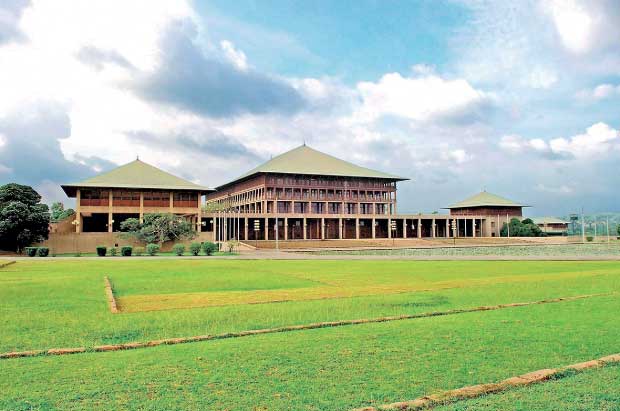Reply To:
Name - Reply Comment

 The new Constitution proposals of the Steering Committee of the Constitutional Assembly are already facing criticism by the Joint opposition in Parliament and there are protests and agitation outside parliament by nationalist elements.
The new Constitution proposals of the Steering Committee of the Constitutional Assembly are already facing criticism by the Joint opposition in Parliament and there are protests and agitation outside parliament by nationalist elements.
Ultimately a new Constitution must be acceptable to all sections of the Country. The LLRC Report refers to the need for “reaching a political settlement that addresses the grievances of all communities and the aspirations and acceptability of all communities” when we consider the APRC (All Party Representatives Committee) Report of 2010, it seems to provide an answer to the present acrimonious situation. The Government can constructively engage the Rajapaksa led ‘Joint Opposition’ by taking up the APRC constitution proposals for discussion as they were initiated by Former President Mahinda Rajapaksa.
The SLFP both those with the present Government and those in the Joint opposition, as well as the other constituent parties in the Joint Opposition are all signatories to these proposals. Both sides must show statesmanship and think in terms of the good of the country rather than one-upmanship vis a vis the other side. The dire economic situation and the disasters that have overtaken the country make it imperative that we work out a political settlement so that we are not again faced with an ethnically divided country, and the adverse repercussions thereof.
The APRC Constitution proposals have the acceptance of the following parties who participated, namely SLFP, MEP, JHU, LSSP, CP, the Sri Lanka Muslim Congress and other Muslim parties, the CWC, Upcountry People’s Front, Western Province People’s fFont, EPDP and TMVP. The two major non-participants are the TNA and the UNP. The TNA would have in all probability supported these proposals with some reservations. Initially the TNA did not participate in the APRC because the LTTE which was then a party to the 2002 ceasefire agreement and militarily dominant in the north and east perceived the APRC as a unilateral process that the Rajapaksa govt. had commenced excluding them. The TNA members could not defy the LTTE for fear of their lives.
The UNP stayed away for reasons which are unclear including the allegation of the regime having engineered a split within the UNP, although it may be construed as following the policy of the two major parties thus far, which was to oppose the attempt of the other party to solve the national question. In the national interest, the two parties which did not participate should with an open mind study the report and if acceptable to them agree to implement it with or without reservations. The parties which have already accepted it and signed cannot now go back on it without their sincerity being questioned. Hence the joint opposition will also be constrained to go along with the proposals and could even take the credit for its good features.

To give a brief background, President Mahinda Rajapakse in July 2006, appointed a committee of the Representatives of the parties, called the All Party Representatives Committee (APRC) and mandated it to formulate a draft proposal for Constitutional Reform. The President called upon the Committee to evolve a home-grown Constitution which would provide a comprehensive approach to the resolution of the national question. To quote Kariyappar and Yogarajan who were members of the APRC, the APRC since July 2006 met weekly almost every week, deliberating more than 3-4 hours each time. A panel of experts was also constituted to advise the APRC”. The panel which consisted of a wide spectrum of opinion included lawyers H.L de Silva, Jayampathy Wickremaratne and Gomin Dayasri as also seasoned administrators like K.H.J. Wijayadasa, and persons who had served in legal and financial capacities. The Experts Committee produced two Reports after many months of intensive consultations in December 2006. Based on these reports, Chairman of the APRC, Prof. Vitharana presented a draft containing the main features to form the basis of a new Constitution in August 2007.
This draft consisted of 21 chapters. Each of the chapters was discussed by the APRC at its meetings. These meetings 128 in number were completed in June 2010, by which time the Committee had reached consensus in respect of almost all the chapters. It was agreed that based on this consensus a final report be compiled by the Chairman Prof. Vitharana. It was accordingly compiled and presented to MR. But as in the case of most reports, no further action was taken. The report was not presented to the public or to the two parties which had not participated namely the TNA and the UNP. However a report compiled by Kariyappar of the SLMC and Yogarajan of the CWC, is in the public domain, and can be accessed.
There is to be a Vice president from a community other than that of the President. Question of Merger of provinces can be considered in accordance with the provisions presently available in the 1978 Constitution
Kusal Perera, writing in the Daily Mirror of May 19, 2017, points out that “Ironically it is Rajapaksa who had two well crafted Reports done under his presidency that could ensure reconciliation and a consensual political solution to the ethnic conflict ……but he left them in cold storage”. The first is the APRC Report and the other is the LLRC Recommendations. Kusal Perera states “If this government is honestly serious in finding a decent consensual answer to the festering ethnic conflict all it has to do is to table the two reports in Parliament for discussion and approval. There is absolutely no necessity for anyone to waste time reinventing the cycle (Wheel) that Rajapaksa most effectively and successfully concluded”. I would tend to agree with this statement. Although the present Government may feel that this is a prestige issue, and that the Constitutional Proposals must come from the presently constituted Constitutional Assembly the Government and the opposition must in the national interest get to together and accept the APRC proposals which we understand are among the proposals being considered to be a basis for deliberation thus pulling the constitutional reform process out of its present impasse and not allow it to once again bring about divisions on ethnic and communal lines.
I give below some of the salient features of the APRC Constitution proposal which have had the approval of so many political parties. Firstly the nature of the State, this is described as follows. The Republic of Sri Lanka is a unitary state in the sense in which it shall be deemed to be an undivided and integrated state structure where the state power shall be shared by the Centre and the provinces”. On the status of Buddhism, “the Republic of Sri Lanka will give to Buddhism the foremost place and it shall be the duty of the state to protect and foster the Buddha Sasana while according to all religions the rights guaranteed by Articles 10 and 14 (1) (e) of the 1978 Constitution. Form of Government, Sri Lanka shall adopt a Parliamentary form of Government at the Centre. A second chamber the Senate to be created. The Supremacy of the Constitution is a feature of the Constitution as also are the safeguards against secession. The electoral system to be a mixed one. On Power sharing, the powers of the people to be shared at 3 tiers of the government, namely by the Central Government, Provincial government and the local government. Each tier to have separate lists of powers provided. The local government tier is based on the Grama Sabha and the Ward Sabha respectively at the villages and town level and they can make the relevant by-laws. Apart from the Provincial Councils powers to be also devolved to District Councils, without retaining all of them at the provincial level. Also non territorial ‘Community Councils’ to be instituted for the welfare of Muslims living outside the Eastern province and for Up Country Tamils (also known as Tamils of Indian origin) living in the central and other provinces.
The national executive to consist of Prime Minister and Ministers. There is to be only Cabinet of Ministers and Deputy Ministers. The number of cabinet ministers including the PM not to exceed 30. The Cabinet of Ministers should in principle reflect the pluralistic character of Sri Lanka and also be representative of the Provinces. The President to be elected by both houses of Parliament. There is to be a Vice president from a community other than that of the President. Question of Merger of provinces can be considered in accordance with the provisions presently available in the 1978 Constitution and the Provincial Councils Act of 1987. The establishment of a Constitutional Court. The Establishment of a single Court of Appeal sitting in each of the nine provinces. The Court of Appeal to be possessed of original jurisdiction over violations of fundamental rights arising out of an infringement or imminent infringement by provincial or administrative action. The report also deals with Individual and group Rights, and the setting up of a bi lingual administration, among other matters. These are some of the features of the proposed Constitution which was the outcome of the consensus at the APRC consultations held between 2006 – 2010.
The writer was a member of the Experts Committee appointed by Former President Rajapaksa to advise the APRC in 2006.